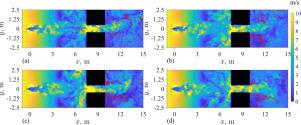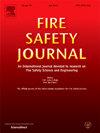A computational study of the deposition of firebrands between two side-by-side blocks
IF 3.4
3区 工程技术
Q2 ENGINEERING, CIVIL
引用次数: 0
Abstract
The deposition of firebrands between two blocks, representing neighboring simplified structures, was investigated by large-eddy simulation and Lagrangian tracking of firebrands. Fire Dynamics Simulator was modified and implemented for simulations. The computational configuration resembled the previous wind-tunnel measurement setup including two blocks and the firebrand generator apparatus, aka NIST Dragon (Suzuki and Manzello 2021). Different wind speeds and frictional coefficients between the sliding firebrands and the ground were considered. Simulations revealed several flow effects influencing the motion of firebrands on the ground, such as re-circulation flow in the wake of the dragon, a crossflow upwind of the blocks, and twin re-circulation regions on leeward and windward sides of the blocks. At lower wind speeds, firebrands were accumulated somewhere between the dragon and the blocks, consistent with observations in the previous measurements. At higher wind speeds, the firebrands tended to accumulate momentarily before the crossflow region and then accelerate through the gap between the blocks. Some accumulated in the leeward corner of the blocks. Firebrands displayed much more dispersion in the streamwise direction compared to the spanwise direction because the normal component of the Reynolds stress was greater in the streamwise direction.

两块并排木块之间火带沉积的计算研究
通过大涡流模拟和火带拉格朗日跟踪,研究了代表相邻简化结构的两个区块之间的火带沉积情况。对火灾动力学模拟器进行了修改并用于模拟。计算配置类似于之前的风洞测量设置,包括两个区块和火带发生器设备,又名 NIST Dragon(Suzuki 和 Manzello,2021 年)。考虑了不同的风速和滑动火带与地面之间的摩擦系数。模拟显示了影响火龙在地面上运动的几种流动效应,如火龙尾部的再循环流、火龙块上风处的交叉流以及火龙块背风面和迎风面上的孪生再循环区。在较低风速下,火带聚集在龙和木块之间的某处,这与之前的测量结果一致。风速较高时,火带往往在交叉流区域之前瞬间聚集,然后加速穿过木块之间的缝隙。一些火带聚集在木块的背风角。由于雷诺应力的法向分量在流向方向上更大,因此火烧带在流向方向上的分散程度远高于跨向方向。
本文章由计算机程序翻译,如有差异,请以英文原文为准。
求助全文
约1分钟内获得全文
求助全文
来源期刊

Fire Safety Journal
工程技术-材料科学:综合
CiteScore
5.70
自引率
9.70%
发文量
153
审稿时长
60 days
期刊介绍:
Fire Safety Journal is the leading publication dealing with all aspects of fire safety engineering. Its scope is purposefully wide, as it is deemed important to encourage papers from all sources within this multidisciplinary subject, thus providing a forum for its further development as a distinct engineering discipline. This is an essential step towards gaining a status equal to that enjoyed by the other engineering disciplines.
 求助内容:
求助内容: 应助结果提醒方式:
应助结果提醒方式:


